Tapestry was one of the most anticipated and hyped board games of 2019. This Tapestry Board Game Review is my take on whether it fulfills expectations.
Introduction to Tapestry Board Game Review
Stonemaier Games is one of the hottest publishers in modern board gaming and 2019 was particularly important for them. They launched two big titles, Wingspan and Tapestry. Thanks to previous titles, especially Scythe and Viticulture, expectations from fans were huge.
While the design of Wingspan was trusted to Elizabeth Hargrave, Tapestry is the work of the company’s main figure, Jamey Stegmaier.
In Tapestry, you are in charge of a civilization. You progress, explore, conquer, invent technologies, build your capital and write your own story by playing tapestry cards. The game is played for a set number of eras and the civilization with the most points is declared the winner.
But is the game worth your money? Is it fun to play? Answers in the conclusion – but first, some information about the game.
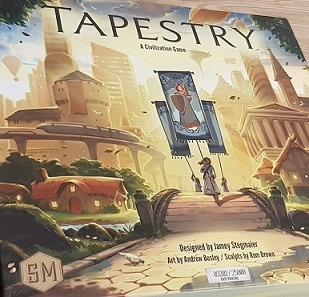
Tapestry Facts
Players: 1-5, plays well with all numbers.
Playing time: depends on player count. A solo game can be finished in an hour, while games with more players may take up to two hours.
Complexity: medium, recommended ages 12
Tiny Little Buildings
There’s only one way to start this review: the miniatures used as buildings. They are the stars of Tapestry and rightfully so. Made of plastic, very detailed and beautifully painted. There are so many small features on them, you won’t even notice them during normal gameplay, only if you look closely.
However, this must have been a very expensive development and manufacturing process and I’d be very curious to find out how much they contribute to the final cost of the game and if would it have been cheaper to make something similar from wood or cardboard.
Buildings are just slightly smaller than the squares you put them on – on your capital mat, so overall they fit nicely together when you build your capital. Except for the rubber factory, which dimensions are weird (see picture) and frankly too small for the space they should fit in.
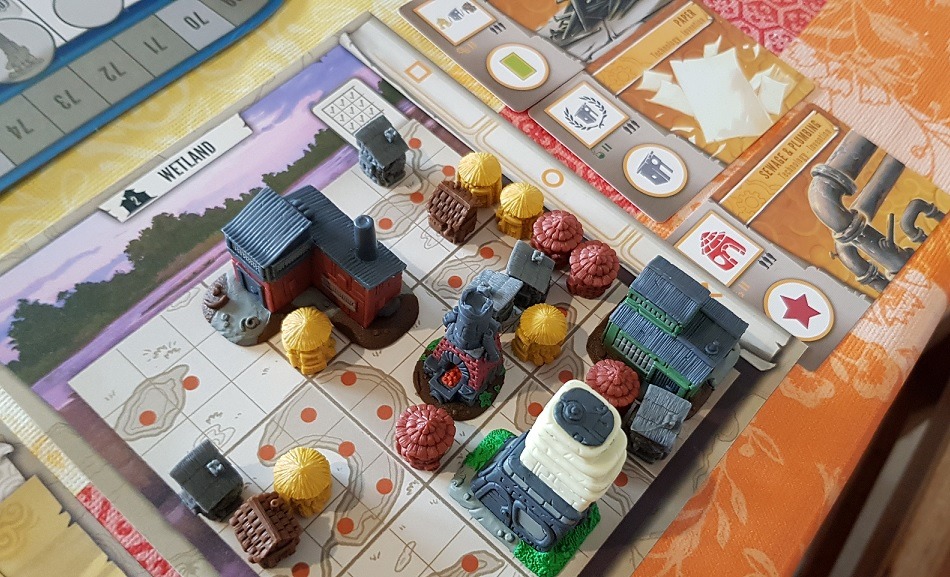
Artwork
Complimentary with miniatures is the artwork. The map is bright and colorful, the tiles look great, fit perfectly and form a picturesque map. Illustrations on tapestry cards and invention cards are a joy to look at (although I didn’t really pay much attention to them during the game itself).
Player boards are made of plastic with a nice sandpaper overcoat, which prevents pieces on them from moving. They suffer a bit from twisting, but nothing too serious. Edges are very sensitive to damage.
Cards’ edges also have a tendency to get damaged easily (after 1 drop of a card, for example), but the front and back are high quality. Similar is the thing with the actual game board – very vulnerable along the folding edges. But since it is double-sided (no luxury to glue a piece of fabric to one side to hold it together), I don’t see how this could be much improved.
The Insert Issue
But this is all minor compared to the insert issue. It goes along with miniatures being the stars of the show, as it doesn’t leave much space in the box for anything else. Miniatures, meanwhile, receive a king-like treatment: each has it is own slot and the overall box space utilization is pretty terrible. And based on the material they’re made of (soft plastic), buildings don’t really need the protection they get.
That leaves everything else packed in plastic bags, which is a terrible choice for multiple reasons. First, it is a bad box design and it looks like after they made the insert, they remembered there’s more to the game than just miniatures.
Second, it makes it a real pain to set up the game and store it away afterward. OK, after a few plays you pretty much know what you need and what not and you pack the bags accordingly to speed up the process. But I also found myself wanting to play a game of Tapestry, but after the plastic-bags-issue thought came to my head, the urge went away.
Third, it means the already vulnerable boards and cards are even more susceptible to damage, especially if you transport the game a lot. Yes, it’s not the only game that uses plastic bags to store its components. But Stonemeier games charge a premium price for their game, therefore we expect a premium product. If they bothered with an insert for the minis, they could have extended it to all the other components.
Faction, Income, and Capital Mats
The first thing to do in Tapestry is to pick a group of people you’ll play as. Factions are not nation-based, but rather mindset-based: Leaders, Inventors, Militants, Traders, Futurists, and so on. Each comes with it its own set of special abilities, usually bonuses on their faction mat, which you activate when you achieve certain milestones, normally at income turn.
Read about all available factions in Tapestry
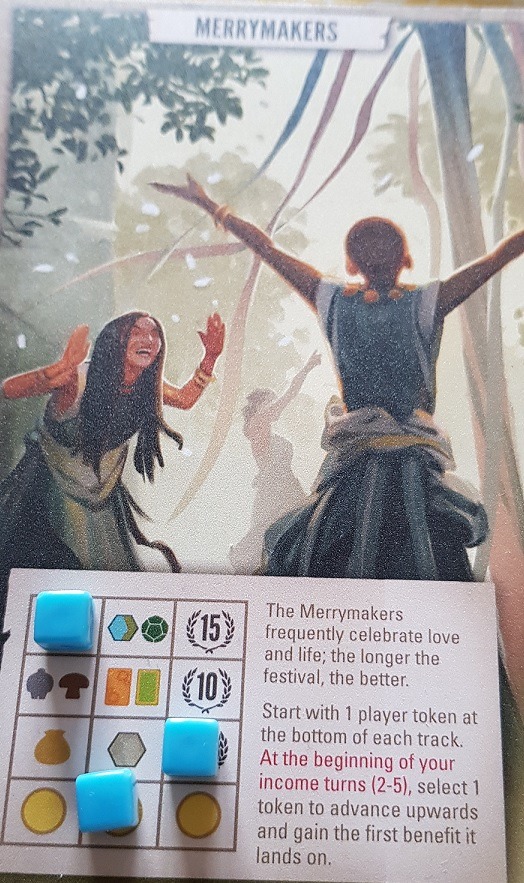
The income mat is your main working area. It tracks how many resources you have, how many armories, markets, houses, or farms you’ve built (along with corresponding bonuses), and is a place where you play your tapestry cards. To the right of it, you have your capital mat.
The Capital mat is where you place buildings and landmarks, filling out a 9×9 grid. For every 3×3 square, you get a bonus resource and you get points (at income) for every completed row and column. The trick is that some tiles in the grid are impassable, giving you a simple Tetris-like puzzle. There are six different capital mats available, just to keep things fresh.
Course of Play
Your play will consist of two actions: either you make an income turn or advance on a track. The latter is what you’ll be doing most of the time, so let’s look at that first.
There are four tracks encircling the game map: science, technology, exploration, and military. Every track has 12 steps and every time you progress a step, you must pay a price in resources. Initial steps are cheap and they get more expensive as you progress.
In return, you get benefits and bonuses (you need to pay extra for those). Benefits and bonuses can be: inventing a technology card, rolling a science die (helping you progress on a different track), exploring a tile on a map, conquering a tile, drawing a tapestry card, placing a building from your income mat to your capital mat and similar. The higher up the ladder you progress, the more powerful and specialized the benefits get.
There are certain steps that grant a landmark to the first player. Landmarks are larger buildings that go onto your capital mat, covering more tiles, and making it easier to fill. They are worth racing to; for example, the tank factory is 3×3, giving you an instant bonus if placed correctly. Certain landmarks can only be gained from technology cards.
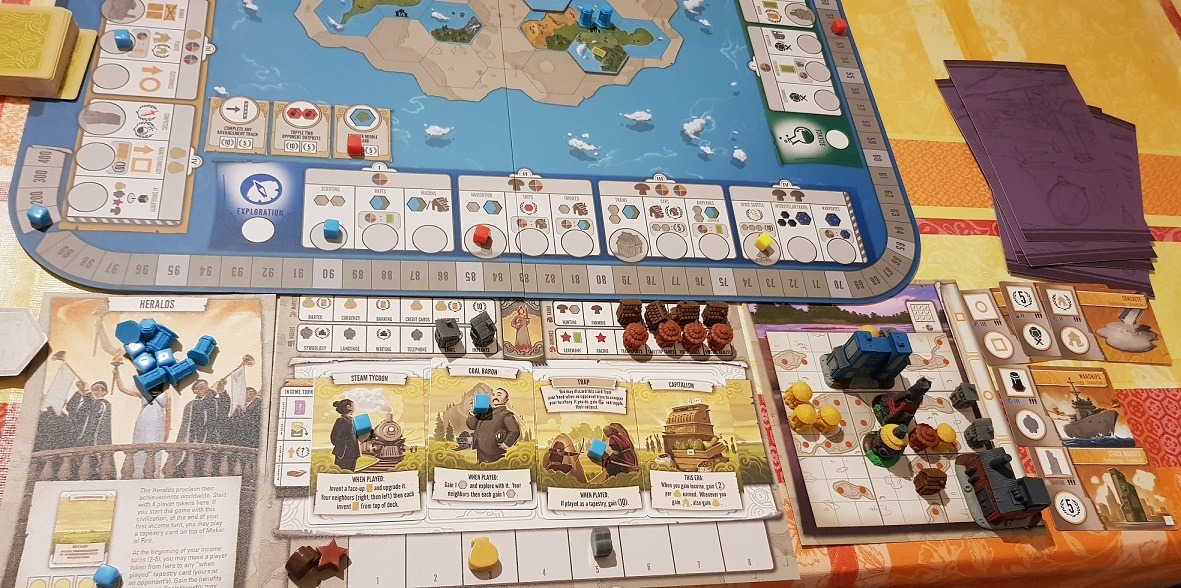
Income Turn
You can progress on tracks as long as you have the resources to do so. When you run out, it is time to take an income turn. Income turn is scoring everything you did so far.
- First, you get your faction benefits, described on your faction mat.
- Then it is time to play a tapestry card onto your income mat. Tapestry cards are named after historic “events”, like Democracy, Coal Baron, Feudalism, Revolution, and Industrialism. They are powerful abilities (some very situational) that define your civilization in an era, granting big bonuses. You’ll usually have several to choose from and choose the one that correlates with your other goals (i.e. if you’re progressing on the military track, conquering tiles, you’ll want a tapestry card that gives a bonus to that).
- Upgrading one of your technology cards is next. They represent historical inventions and technologies: concrete, assembly line, eyeglasses, irrigation, the light bulb, and the compass, to name a few. When you first gain a tech card, it is put into the bottom row, from where you can upgrade it. Only then you’ll receive bonuses: buildings, resources, tech cards, tapestry cards, victory points, landmarks, conquer actions, exploration actions, and so on. You can upgrade each tech card twice – the second upgrade provides even larger gains.
- Now is the time for scoring, accounting for how well you did so far: you get points for tech cards, capital mat (those rows and columns you completed), territories you control, and any other bonus tiles you uncovered on your income mat.
- Lastly, you will get resources – again depending on how many tiles you uncovered on your income mat so far. With those, you can then go back to progressing on the tracks.
There are five income turns per player. While the first won’t generate any victory points, things start to snowball and your fifth income turn will be the most profitable by far.
After you are done with your last income turn, you are finished with your play. Other players may still play on, as long as they have the resources to do so. If the players are of similar skill, they won’t finish the game much apart.
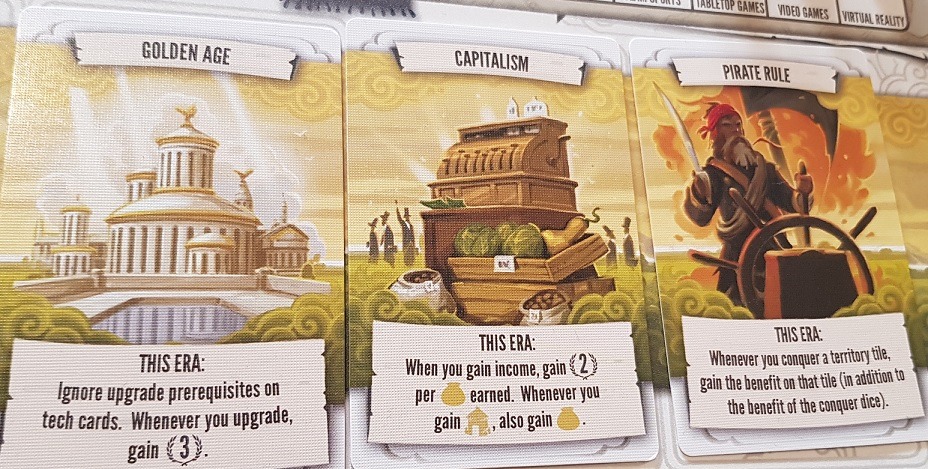
Interface and Manual
All the actions, resources, bonuses, and benefits are pictured in easy-to-recognize icons, which are consistent all around the board and cards. That makes them easy to distinguish and very intuitive. Sure, you need a couple of games to adapt, but after that, you know instantly what you must pay or you get.
Unfortunately, the manual is a little sub-par. It’s only four pages long, so it is very congested. All the essential information is there, but I would like some more clarifications and examples. I had trouble figuring out which steps should I take on my first income, only to find out (after I watched a YouTube video) that it is all neatly numbered on the mat and pretty straightforward.
The game is not complicated once you get a hang of it, but trying to learn it just from the manual was close to impossible. You shouldn’t have to resort to YouTube to learn a game, just because the developer wanted to keep the rules to four pages.
Ironically, this isn’t actually true – you get another tiny rule book for the automa (solo mode) and another sheet for the shadow empire. Don’t forget another paper for the reference guides. Why not make just one larger, comprehensive rule book to cover all of it, instead of having already inadequate information crumbled all over different papers?
How is the Gameplay?
First of all, let me emphasize that I had a lot of fun playing Tapestry. Choosing where to progress is like being in a toy store with all the shiny things around you. Almost everything you do, you get immediately rewarded.
Whether you progress on a track, develop your capital, use your faction mat or pick a technology, you always have a feeling you’re building something, an engine. It’s not that different from building an engine in Scythe, but in Tapestry your actions are limited by tech tracks.
Choosing which track to progress requires careful planning and resource management. Some actions even affect other tracks, so the order is also valid. This becomes increasingly important towards the end game.
Bonuses for points multiply as you progress, therefore it is best to focus on one or two tracks and only get the cheapest from the rest to maximize your end result. I enjoyed planning my moves, solving the puzzle on my capital mat, and playing tapestry cards. Especially if you draw just the right tapestry card, that will really complement and compound the direction you’ve gone so far.
There is not much player-vs-player interaction. Yes, you can conquer each other’s tiles, but that’s not easy to do (due to “trap” cards that the defender can play) and is not a common occurrence. Some factions have abilities that interact with others (like Traders or Historians), but other than that, you’re main interaction will be a race on those tracks. The race towards landmarks and the extra points for being the first to complete a track.
Because of the above, the gameplay is very similar for all player counts. Most of all, you are focused on your own play. Three to four players seems to be the sweet spot and only with five players competing for those landmarks becomes harsh.
Tapestry is also very good in two-player mode or solo. A very capable automa is implemented to compete against, along with a simplified automa (the Shadow empire) which is there to compete for landmarks only. Certain (interactive) tapestry and tech cards have to be removed for solo play, but overall I found it a well-round up experience and quite a challenge.
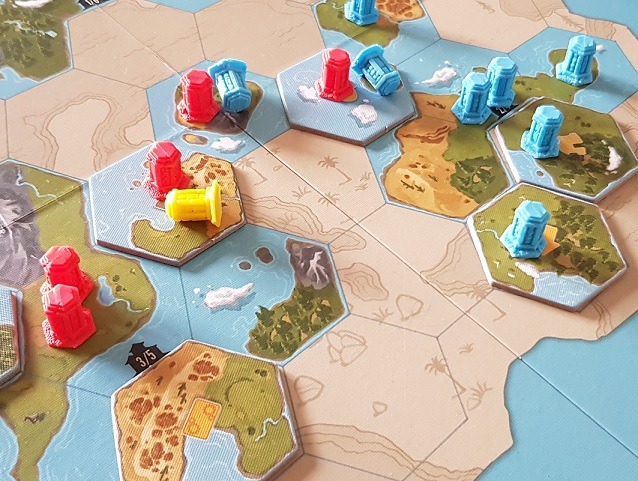
Not All is Perfect
Of course, every rose has its thorn(s) and Tapestry is no different.
Let’s start with factions. There are sixteen of them and they vary in their capabilities a lot. I’d say to the point that some are more useful than others. In theory, they should be balanced and Stonemaier games made updates (the latest from November 2021) to balance them out, but I can’t shake the feeling that some have universally useful bonuses, while others are very situational, dare I say weaker.
Similar is the thing with tapestry cards. There will be games where you’ll get just the right card and others where you’ll get nothing but useless tapestry cards. I know that you always have to make the best of what you have, but sometimes your hands are overly tied.
If in such a game your opponent should be luckier, there’s not much you can do to turn the tide. I think that faction mats and tapestry cards have too big of an impact on the end result and diminish players’ decisions.
Progress tracks
Some spaces on tracks towards the end are a real disappointment. They don’t feel worth the resources you spend and the only reason you’ll climb to the top of the track is that you’ve already invested so much. Space tiles (the end-game of exploration tech track) seem to be a total waste of idea and cardboard – in my dozen games, not a single space tile has been drawn.
Science track sometimes has the benefit of rolling a science die. This means you progress on a track you throw for free, but you don’t necessarily get the benefits of that progression.
And that is the most frustrating thing ever. You’ve progressed on your tech track, so you will get a tech upgrade at your next progression. But then for some reason (maybe to be the first to complete a track or get a landmark), you decide to progress on the science track. You roll that die, get a tech track progression, progress, and basically skip your desired benefit. Not fun at all.
Just to mention, there is also a science die, where you get the benefit of the other track. This is super useful and satisfying, but having no-benefit die on the track, I’ve built a resent for the science track. Other players share my thoughts.
Jack of all trades – master of none
Tapestry wants to do a lot of things and it barely scratches a surface on most of them. Exploring is nothing more than placing a tile, conquering is nothing more than placing an outpost and rolling dice, progression is linear and tracks are independent. You can be at the end of one and not even start on the other and get no penalties for it. It doesn’t feel very civilized when you’re studying alien biology on one track and are still discovering stone tools on the other.
For a civilization game, mechanisms should be deeper and players should have more options, and not be limited by linear tracks. As is, Tapestry is nothing more than a medium complexity eurogame, wrapped into a civ theme. It’s not a bad eurogame, but maybe a more focused theme would better suit it.
Verdict: Good but Expensive
I can forgive all the above shortcomings (as well as problems with the insert) and take Tapestry for what it is. The gameplay is smooth and, as said, I had plenty of fun with it, and the issues are not game-breaking. The developer is also working on balance constantly and expansions (there are two available), which means they care for the game.
But I cannot forgive the high price tag. It comes to nearly a hundred dollars (although, it’s often discounted), which is in a similar category as, let’s say Mage Knight, a game directed to the most hard-core of board gamers.
But hard-core board gamers are not going to be kept busy with Tapestry for too long. It’s way too shallow for that. With its playing time, complexity, and player count, it is an ideal family (or entry to mid-level) board game. But a family game for a hundred bucks? I’ll let your wallet decide.
I’d personally much rather go with something like Wingspan. Same publisher, similar in complexity but much more affordable.
Do you like what you just read? Consider subscribing for more content:
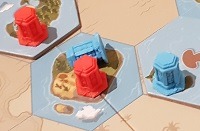

This is my first time hearing of the Tapestry game but your review was so nicely done that I have no doubt that it’s going to be a fun board game to play with family or friends. I appreciate you properly giving a detailed and in-depth review of the Tapestry board game, the pros and cons, gameplay, and also information on the price.
Thanks, I appreciate the kind word and am glad that you liked my review. There are more game reviews on the site, check them out!